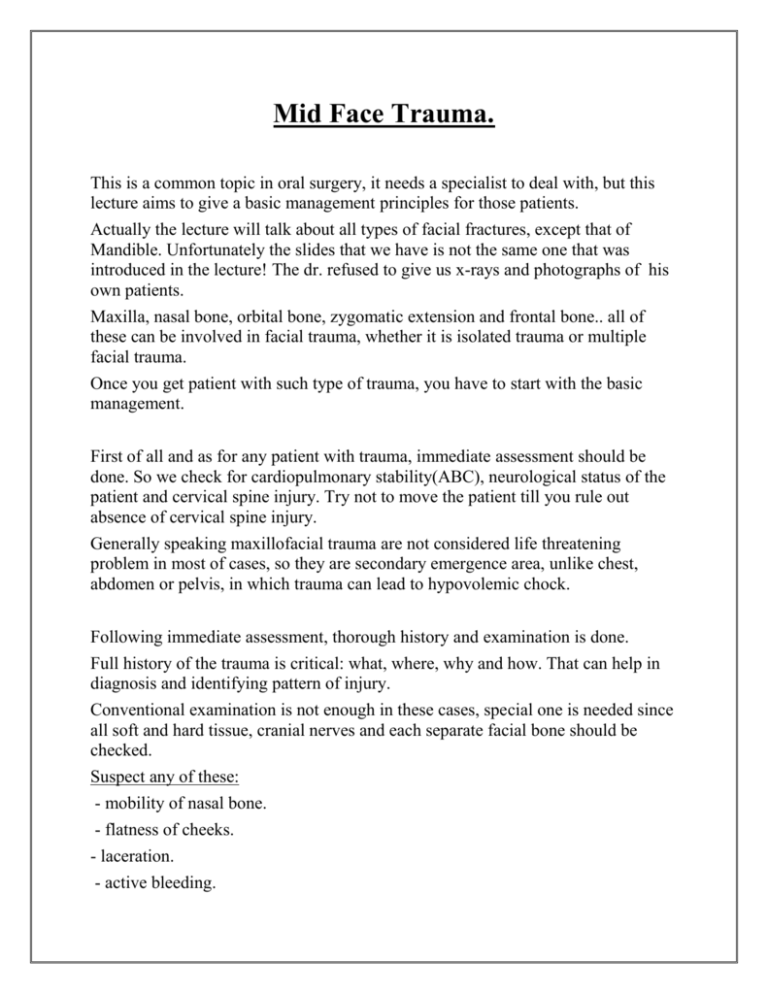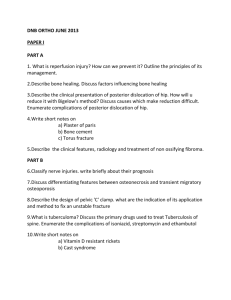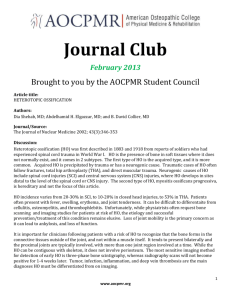Oral SurgeryII,Sheet18 - Clinical Jude
advertisement

Mid Face Trauma. This is a common topic in oral surgery, it needs a specialist to deal with, but this lecture aims to give a basic management principles for those patients. Actually the lecture will talk about all types of facial fractures, except that of Mandible. Unfortunately the slides that we have is not the same one that was introduced in the lecture! The dr. refused to give us x-rays and photographs of his own patients. Maxilla, nasal bone, orbital bone, zygomatic extension and frontal bone.. all of these can be involved in facial trauma, whether it is isolated trauma or multiple facial trauma. Once you get patient with such type of trauma, you have to start with the basic management. First of all and as for any patient with trauma, immediate assessment should be done. So we check for cardiopulmonary stability(ABC), neurological status of the patient and cervical spine injury. Try not to move the patient till you rule out absence of cervical spine injury. Generally speaking maxillofacial trauma are not considered life threatening problem in most of cases, so they are secondary emergence area, unlike chest, abdomen or pelvis, in which trauma can lead to hypovolemic chock. Following immediate assessment, thorough history and examination is done. Full history of the trauma is critical: what, where, why and how. That can help in diagnosis and identifying pattern of injury. Conventional examination is not enough in these cases, special one is needed since all soft and hard tissue, cranial nerves and each separate facial bone should be checked. Suspect any of these: - mobility of nasal bone. - flatness of cheeks. - laceration. - active bleeding. - intraoral trauma: laceration, sublingual hematoma- which indicates fracture in alveolus mandible or maxilla-, malocclusion-which indicates bony fracture in one of the jaws- and teeth mobility. -periorbital ecchymosis: redness of skin around orbits. - facial edema and swelling. -bleeding from the nose- Epistaxis, it might be mixed with whitish fluid, CSF, if trauma reached anterior cranium fossa. - asymmetry: fracture and displacement of facial bone. - Telecanthus: increased distance between the eyes, possibly following nasalethmoidal fracture that result in distortion in medial canthal ligaments. - nasal bed depression or flattening ,following nasal bridge fracture. After immediate assessment and history/examination, further investigation by taking radiographs is done. Those patients are of different needs than regular patients, but since they usually come to the ER, not all methods of taking radiographs may exist, even the panorama. Common x-rays: Occipitomental x-ray, Lateral skull x-ray and AnterioPosterior skull x-ray. Or we can go directly for CT, which provide detailed anatomy and clearer idea about the severity of the fracture. MRI is used for soft tissue lesion which not so important for bony fractures. Now and after all the previous steps we can start more elective maxillofacial procedure. The dr. showed us photographs for a pt fail from 5th floor, there were bilateral periorbital eccymosis, laceration, asymmetrical nasal bone and generalized facial edema. The patient was stable for short period of time, then had disseminated intravenous thrombosis and died. Photographs for another pt. We saw circumoral edema, here the trauma is more localized to the oral cavity area so the intubation was given through the nose before operation of the mandibular fracture. It is very important here not to move pt head till u exclude c-spinal injury. Dr. showed a 3D radiograph for patient with gunshot. Such type of photos contain more artifacts and not precise as segmental CT. Multiple fractures and discontinuities in multiple facial bone: frontal bone, lateral side of orbital wall, orbital floor, lateral side of nasal bone and the mandible. Patient relatives claim that the pt was trying to suicide! But that was not the case, they were trying to kill him!. This important for forensic issues and patient safety as his relatives should not be allowed to enter ICU. Why we have mid-facial trauma? - road traffic accidents. - fights. - falls. - work related traumas. - gun shots which is more common in our countries as in western countries it results in killing not in traumas because it is taken off by professionals. Classification of mid-face trauma: - the most common is that of French surgeon, LeFort classification, related to pattern of trauma. I: separation of the maxilla from the mid face. So the fracture is within the maxilla, above roots of teeth, below the nasal fossa and extend posteriorly to ptyregomaxillary fissure. II: fracture in maxillary and nasal bone. It is pyramidal or triangular in shape. III: full detachment of facial bone. Note: We can have different LeFort classes on each side of the face. - Another classification system called zygomatico-maxillary bone complex fracture: -zygomatic maxillary bone fracture. -zygomatic arch fracture. -nasal ethmoidal frontal bone fracture. Another photographs for a patient with a road traffic accident, symptoms: bilateral ecchymosis, swelling, nasal deviation, laceration and mid palatal fracture which resulted in severe median diastema. In the 3D CT, subcondylar fracture and zygomatic fracture are obvious. The patient has LeFort class I on one side and class II on the other. Treatment for this patient is reduction and fixation. Inside the operation there was difficulty in attaining occlusion anteriorly because the patient already has anterior open bite, what the dr. realize following the operation. Another case: an axial scan of CT for a patient with mid facial trauma, both maxillary sinuses are filled with fluid (blood), there is nasal symptoms (record here is not clear) and on the right side the whole zygomatic bone/arch are depressed. In such a patient oral function (chewing, speech,..) and esthetics are lost, so the treatment goal is to achieve a maximum reduction in order to attain rehabilitation and accelerate bone healing so that ocular, nasal and masticatory function can be recovered along with acceptable facial and dental esthetics. In rehabilitation operation of the face we have to achieve good reduction of facial pillars into their original sites so that successful re-contouring of the face can be achieved. Facial pillars: - frontal bone. - zygomatic arch: give anterioposterior contour or what is called cheeks prominence. - maxilla: give nice complex profile of the face. - mandibular plate or chin: any depression in it result in what is called retrognathia. Surgeons try to give the exact anatomy during treatment by different methods, for example we have open/closed reduction. * open: by opening surgically (making incision) to reach the area. * closed: without reaching area surgically. For example: when we have unilateral condylar fracture, reduction is done by intermaxillary fixation for 6 weeks. Following reduction we have to fix bony segments in their original place. We can use for that: - titanium plates(bone plates) and screws, most commonly used. We have different sizes( 2mm, miniplates,…) - stainless steel wires-suspension wires: we make holes to insert them and then we tie them. They are not used a lot nowadays because they don't give rigid fixation. So we avoid using them esp. for facial pillars fixation. And in case we use them we have to make IMF as well and that will not work for pillars. IMF: not used a lot recently, with development of Ti plates and screws. In the past they were common with SS wires. Note: Ti plates and screws are more modern and stable method, no need to do IMF with them, instead ortho. elastics can be used to provide proprioception and guidance. The dr. showed us how IMF is done, we arch bar on upper and lower teeth and we tie them by interdental wires after that the two bars are joined together. There is another method in which screws are used instead of the bars. Zygomatic bone : as we know it has four extensions: cheek prominence, frontal process, maxillary process and that process of zygomatic arch. So this bone is like a star and when it fracture it will rotate. If we have trauma on that bone we access it through the laceration, if it’s exist. If no laceration was there, we can reach frontal process through eye brow incision, through infraorbital incision we can reach infraorbital ridge and intra orally by going sublabially then up we reach the body of zygoma. So we can get accesses in esthetic way . Talking about zygomatic arch fracture, pt will suffer from swelling, pain,..etc but the characteristic feature is limitation in mouth opening because when this bone goes inward following fracture coronoid process movement will be hindered. It can unilateral, which is more common, or bilateral ( حدا حط رأس المريض على األرض و )دعس عليه The most common approach to treat such type of fracture is called Gillies, a British surgeon. It is closed type of reduction, used when the fracture is simple and not comminuted. An incision at temporal area is done and we insert Gillies elevator between superficial temporal fascia and the temporalis muscle fascia( deep temporal fascia), there is a gap between them and by getting there we are beneath the process so we push it outward. By this approach we avoid facial nerve braches injury and any scar in pt face because the incision area is covered by hair. Another photos for a lady who had scrimmage with her husband, and they were in the car, so he push her out of the car O.o and go back to tread her! On the CT scan there were no fractures, so it is simple soft tissue injury but the blow can be transmitted into the orbital floor resulting in increased intraorbital pressure which can lead to orbital floor fracture because it is so thin. Through that fracture hernia of muscle and orbital content occurs ( orbital blow out). Those pts will complain of double vision esp. at lower gaze due to muscle entrapment. This can be associated with zygomatic fracture. To treat that type of fracture we make incision through lower eye lid ( infraorbital ridge incision), so we go through skin then through orbicularis muscle to reach lower orbital ridge. Then we free muscle and orbital content and add bone graft that is fixed by titanium mesh. The last case was about pt who had a road traffic injury in the UAE in the past and he went through treatment but still has telecanthus due to fracture in nasoethmoidal bone and medial orbital wall. In these cases earlier attendance end with more successful outcome than later because of scaring and fusion of segments so the anatomy is distorted and complete recovery cannot be achieved. The pt was informed about that but he wanted to go through the operation. We cannot reach that area entirely unless we make a coronal incision or what is called face off, and through cranium we go down reaching nasoethmoidal, that is aggressive but it is the only way!. After reaching the area sectioning is done in attempt to fined medial canthal ligament and fix it by S/S wires so that some reduction in intercanthal ligament can be obtained. To reconstruct medial orbital wall, bone graft and mesh is used. Molding of the mesh can be performed on a model that was produced by mirror image of the opposite side aided by computer and modern technology. There was a question: From where to start reconstruction? The dr. said we have to evaluate every case alone, we depend on the most intact or fixed segment. For example if we condylar fracture in the mandible and the mid face is smashed or comminuted , we start by doing fixation to the condyle to make our reference to which maxilla will be reconstructed (by IMF). After that mid face bone attached to maxilla which is relies on the mandible (reference) . If there was any smashed/comminuted bone, we use bone grafts.








